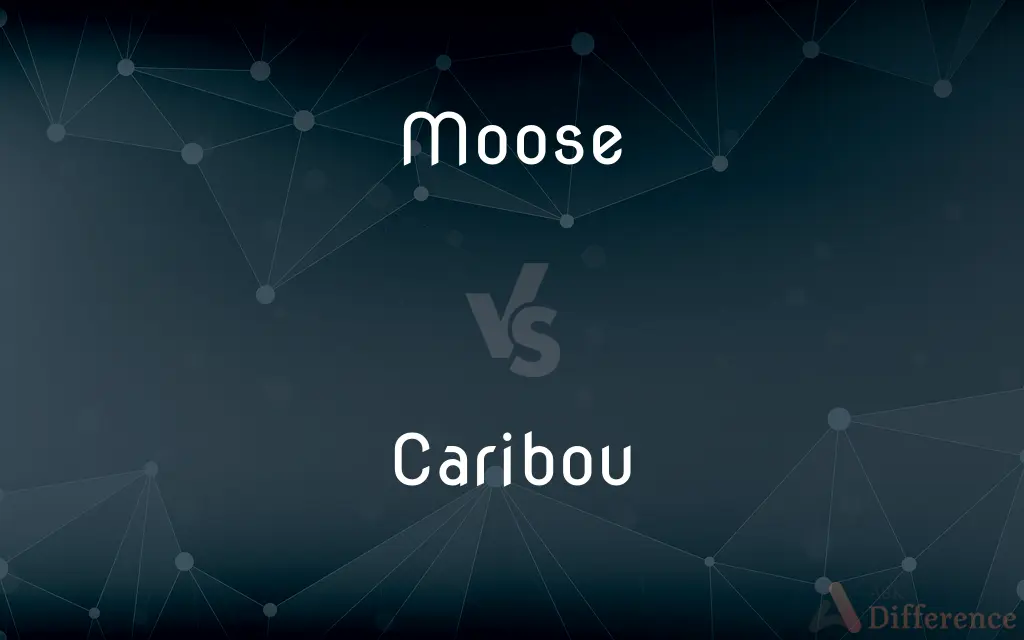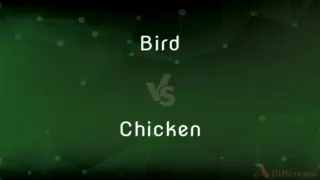Moose vs. Caribou — What's the Difference?
By Tayyaba Rehman — Updated on October 2, 2023
Moose are large, solitary deer with broad, palmate antlers, while caribou, also known as reindeer, are smaller and herd animals with branching antlers.

Difference Between Moose and Caribou
Table of Contents
ADVERTISEMENT
Key Differences
Moose are the largest of the deer species and are characterized by their long faces, drooping noses, and broad, flat antlers. Caribou, on the other hand, have a more compact body shape, a shorter nose, and branching antlers.
In terms of habitat, moose often prefer forested areas where they can feed on young trees and aquatic plants. Caribou are more adapted to tundras and cold, open spaces, migrating long distances to find food.
Behaviorally, moose tend to be solitary creatures, mostly seen alone or in small family units. Caribou are more social, often found in large herds, especially during migration.
Moose are primarily found in North America and northern parts of Eurasia. Caribou, although found in North America, are also known as reindeer in Eurasia and have been domesticated in some areas.
The diet of a moose consists mainly of terrestrial vegetation like leaves, bark, and twigs. Caribou, however, feed on lichens in the winter and a variety of plants during the warmer months.
ADVERTISEMENT
Comparison Chart
Size & Appearance
Largest deer, long face, drooping nose, broad flat antlers.
Smaller, compact body, branching antlers.
Habitat
Forested areas, feeding on young trees and aquatic plants.
Tundras and cold, open spaces, migrating for food.
Behavior
Solitary, seen alone or in small family units.
Social, found in large herds during migration.
Distribution
North America and northern parts of Eurasia.
North America; known as reindeer in Eurasia.
Diet
Terrestrial vegetation: leaves, bark, twigs.
Lichens in winter; variety of plants in warmer months.
Compare with Definitions
Moose
A large deer with broad, flat antlers.
I saw a moose while hiking in the forest.
Caribou
A deer known for its branching antlers.
The caribou herd moved gracefully across the tundra.
Moose
Recognized by its long face and drooping nose.
The distinctive nose makes the moose easy to identify.
Caribou
Also referred to as reindeer in certain regions.
In Scandinavia, a caribou is often called a reindeer.
Moose
Primarily a browser, feeding on terrestrial plants.
The moose munched on the young tree's bark.
Caribou
Eats lichens during the harsh winter months.
During winter, caribou rely heavily on lichens for sustenance.
Moose
A solitary animal preferring forested habitats.
The moose grazed alone near the lake.
Caribou
Adapted to cold, open spaces like the tundra.
The caribou is perfectly suited to the Arctic environment.
Moose
The largest member of the deer family.
That moose stood taller than any deer I've seen.
Caribou
A migratory animal, traveling in large herds.
The caribou migration is a spectacular natural event.
Moose
The moose (in North America) or elk (in Eurasia) (Alces alces), is a member of the New World deer subfamily and is the largest and heaviest extant species in the deer family. Most adult male moose have distinctive broad, palmate ("open-hand shaped") antlers; most other members of the deer family have antlers with a dendritic ("twig-like") configuration.
Caribou
A large deer (Rangifer tarandus) of the Arctic tundra and northern boreal forests, having large hooves and long branched antlers. Subspecies native to Eurasia are usually called reindeer.
Moose
A large deer (Alces alces) of northern North American and Eurasian forests, having a broad pendulous muzzle, humped shoulders, and large, palmate antlers in the male.
Caribou
Any of several North American subspecies of the reindeer, Rangifer tarandus.
Moose
The largest member of the deer family (Alces americanus, sometimes included in Alces alces), of which the male has very large, palmate antlers.
We saw a moose at the edge of the woods.
Caribou
The American reindeer, especially the common or woodland species (Rangifer Caribou).
Moose
Any of the extinct moose-like deer of the genera Cervalces and Libralces.
Caribou
Arctic deer with large antlers in both sexes; called reindeer in Eurasia and caribou in North America
Moose
An ugly person.
Moose
An Asian girl taken as a lover.
Moose
A large cervine mammal (Alces alces syn. Alces machlis, syn Alces Americanus), native of the Northern United States and Canada. The adult male is about as large as a horse, and has very large, palmate antlers. It closely resembles the European elk, and by many Zoologists is considered the same species. See Elk.
Moose
A member of the Progressive Party; a Bull Moose.
Moose
A member of the fraternal organization named Loyal Order of Moose.
Moose
Large northern deer with enormous flattened antlers in the male; called elk in Europe and moose in North America
Common Curiosities
Do caribou migrate?
Yes, caribou are known for their long migrations to find food across tundras.
Where can I typically find a moose in the wild?
Moose are commonly found in forested areas in North America and northern parts of Eurasia.
Are caribou and reindeer the same animal?
Yes, in North America, they are called caribou, and in Eurasia, they are referred to as reindeer.
Are moose social animals like caribou?
No, moose are more solitary, while caribou are social and move in herds.
What do moose typically eat?
Moose primarily feed on terrestrial vegetation, such as leaves, bark, and twigs.
What is the primary winter food source for caribou?
Caribou primarily feed on lichens during the winter months.
What is the main physical distinction between moose and caribou?
Moose have broad, flat antlers and a longer face, while caribou have branching antlers and a more compact body.
Which is the larger animal, moose or caribou?
Moose are the largest species in the deer family, larger than caribou.
Can both moose and caribou be found in North America?
Yes, both species are native to North America.
In which habitats are caribou most commonly found?
Caribou are most commonly found in tundras and cold, open spaces.
Are there different subspecies of moose and caribou?
Yes, there are several subspecies of both moose and caribou, differentiated by their geographic locations and slight variations in appearance.
How can I differentiate between the antlers of a moose and a caribou?
Moose have broad, flat antlers, while caribou have branching antlers.
Is it true that both male and female caribou have antlers?
Yes, unlike most deer species, both male and female caribou grow antlers.
Are moose or caribou endangered?
The status varies by region and subspecies. Some populations are stable, while others are threatened or declining. Always refer to specific conservation sources for up-to-date information.
Are moose or caribou domesticated?
Moose are typically not domesticated, while caribou (reindeer) have been domesticated in some regions.
Share Your Discovery

Previous Comparison
Bird vs. Chicken
Next Comparison
Anorak vs. CagouleAuthor Spotlight
Written by
Tayyaba RehmanTayyaba Rehman is a distinguished writer, currently serving as a primary contributor to askdifference.com. As a researcher in semantics and etymology, Tayyaba's passion for the complexity of languages and their distinctions has found a perfect home on the platform. Tayyaba delves into the intricacies of language, distinguishing between commonly confused words and phrases, thereby providing clarity for readers worldwide.
















































